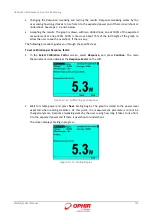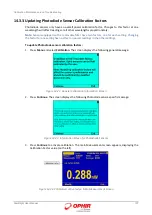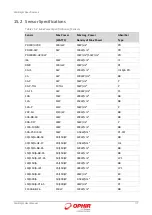
Calibration, Maintenance, and Troubleshooting
StarBright User Manual
109
This coating is available for the PE50, PE25, and PE10 sensors. For even higher damage
thresholds, there are the –DIF diffuser series with a diffuser in front of the absorber.
PD10 Series:
Unlike the other sensors, the PD10 series sensors have a silicon or germanium
Photodiode with a neutral density filter mounted permanently in front of it. The filter detector
combinations are calibrated over the entire wavelength range similarly to the PD300 power
sensors and therefore the sensors have a high accuracy at any wavelength in the range. This is
an exclusive feature with Ophir energy sensors.
Figure
14-27 Absorption of Ophir Pyroelectric Absorbers
14.4.2
Calibration
The sensitivity of the various Ophir Pyroelectric sensors can vary from one to another as well as
with wavelengths. Therefore, Ophir Pyroelectric detectors are individually calibrated against NIST
traceable standards. In addition, there is a wavelength sensitivity correction curve in the meter.
Ophir Pyroelectric detectors are calibrated using a 1064 repetitively pulsed laser referenced to a
NIST traceable Thermopile power meter. The average energy is set to the average power of the
standard power meter divided by the laser frequency. The metallic PE25 and PE50 sensors are also
calibrated with an excimer laser at 248nm to correct the rather large absorption variations in that
spectral region with those sensors.
The spectral absorption of the detector coating is measured spectroscopically and the absorption
curve is used to correct the calibration for other wavelengths. When the user selects his
wavelength on the StarBright, the correction factor for that wavelength is applied.
The PD10 and PD10-PJ sensors are calibrated in a two-step fashion. First the Photodiode detector -
filter combination are calibrated against a NIST traceable master in a similar fashion to the PD300
sensors over the wavelength range of the sensor. Then the sensor is calibrated at one wavelength
using a 905nm repetitively pulsed laser referenced to a NIST traceable Photodiode meter. The
average energy is set to the average power of the standard power meter divided by the laser
frequency.
14.4.3
Accuracy of Calibration
Since the instruments are calibrated against NIST standards, the accuracy is generally 3% at the
energy level and wavelength at which the calibration has been performed. This accuracy has been
verified by checking the scatter of the results when several instruments are calibrated against the
same standard. The maximum error in measurement will be less than the sum of the specified
accuracy, linearity and inaccuracy due to errors in the wavelength curve.













































